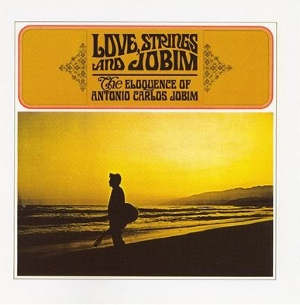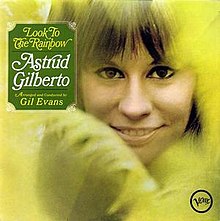
Getz/Gilberto is an album by American saxophonist Stan Getz and Brazilian guitarist João Gilberto, featuring pianist and composer Antônio Carlos Jobim, who also composed many of the tracks. It was released in March 1964 by Verve Records. The album features the vocals of Astrud Gilberto on two tracks, "Garota de Ipanema" and "Corcovado". The artwork was done by artist Olga Albizu. Getz/Gilberto is a jazz and bossa nova album and includes tracks such as "Desafinado", "Corcovado", and "Garota de Ipanema". The last received a Grammy Award for Record of the Year and started Astrud Gilberto's career. "Doralice" and "Para Machucar Meu Coração" strengthened Gilberto's and Jobim's respect for the tradition of pre-bossa nova samba.

Dom Um Romão was a Brazilian jazz drummer and percussionist. Noted for his expressive stylings with the fusion band Weather Report, Romão also recorded with varied notable artists such as Cannonball Adderley, Paul Simon, Antonio Carlos Jobim, Jorge Ben, Sergio Mendes and Brasil '66, and Tony Bennett. He was the percussionist Tom Jobim brought to the studio for the album Jobim recorded with Frank Sinatra in 1967 for Reprise Records, Francis Albert Sinatra & Antônio Carlos Jobim.

Sinatra & Company is an album by American singer Frank Sinatra released in 1971.

Getz/Gilberto #2 is a live album by Stan Getz and João Gilberto, released in 1966. It was recorded at a live concert at Carnegie Hall in October 1964. The previous album Getz/Gilberto won the 1965 Grammy Awards for Best Album of the Year and Best Jazz Instrumental Album - Individual or Group amongst others. The painting on the cover is by Olga Albizu.

The Composer of Desafinado, Plays is the first album by Antônio Carlos Jobim. Released in 1963, the album features a dozen instrumentals arranged by Claus Ogerman, whose work would mark the beginning of a lifelong musical relationship with Jobim. Of these twelve songs, nearly all of them are jazz standards. The opening track "The Girl from Ipanema" is believed to be the second most recorded song in history behind The Beatles' "Yesterday," and a recording of the song by Astrud Gilberto and Stan Getz became a worldwide hit in 1964.

Love, Strings and Jobim is a 1966 album by various Brazilian artists who play new Brazilian songs by various composers. Because Antônio Carlos Jobim is pictured on the cover and mentioned in the title, he has been and continues to be credited to be the performing artist on the album. Jobim does not appear on the album except as a composer. The original Brazilian title of this album is "Tom Jobim Apresenta" and it appeared on the Elenco label.

The Sinatra–Jobim Sessions is a 1979 double LP compilation album of American singer Frank Sinatra's work with Antônio Carlos Jobim. The album was published only in Brazil by producer Roberto Quartin, and had never been re-released on vinyl or CD until 2010 when it was re-mastered and released under The Frank Sinatra Collection and became available worldwide.

Claus Ogerman was a German arranger, conductor, and composer best known for his work with Billie Holiday, Antonio Carlos Jobim, Frank Sinatra, Michael Brecker, and Diana Krall.
"Meditation" is a bossa nova and jazz standard song composed by Antônio Carlos Jobim and Newton Mendonça. The English version has lyrics by Norman Gimbel. In Finland, the song was recorded in 1963 by Olavi Virta with lyrics by Sauki under the title "Hymy, flower and love". Erkki Liikanen recorded the song in 1967 with lyrics by Aarno Raninen under the title "Taas on hiljaisuus".
"Água de Beber" is a bossa nova jazz standard composed by Antônio Carlos Jobim and originally recorded in the key of A minor, with lyrics written by Vinícius de Moraes. The English lyrics were written by Norman Gimbel.

Astrud Gilberto was a Brazilian samba and bossa nova singer and songwriter. She gained international attention in the mid-1960s following her recording of the song "The Girl from Ipanema".

Sinatra/Jobim: The Complete Reprise Recordings is a 2010 compilation album by Frank Sinatra, consisting of 20 tracks he recorded with the Brazilian musician Antônio Carlos Jobim.

Getz Au Go Go is a live album by American saxophonist Stan Getz and his quartet, featuring bossa nova singer Astrud Gilberto. It was recorded during two concerts in 1964 and released on Verve the same year as V6-8600.
"Once I Loved" is a bossa nova and jazz standard song composed in 1960 by Antônio Carlos Jobim, with lyrics by Vinícius de Moraes. Words in English were later added by Ray Gilbert. In a few early cases, the song was also known as, a translation into English of the original Portuguese title.
098 Carlos Jobim]], with Portuguese lyrics by Vinícius de Moraes. English lyrics were written by Ray Gilbert. The song is sometimes titled "Ele é Carioca ."
"Vivo Sonhando" is a bossa nova song from 1962 with words and music by Antônio Carlos Jobim. English lyrics were added later by Gene Lees.
"Fotografia" is a bossa nova song written and composed in 1959 by Antônio Carlos Jobim. English lyrics were published in 1965 by Ray Gilbert.
It's a Quiet Thing is a 1965 album by Morgana King with arrangements by Torrie Zito.
"O Morro Não Tem Vez", also known as "Favela", "O Morro", and "Somewhere in the Hills", is a bossa nova jazz standard composed by Antônio Carlos Jobim with lyrics written by Vinicius de Moraes. The English lyrics were written by Ray Gilbert.











